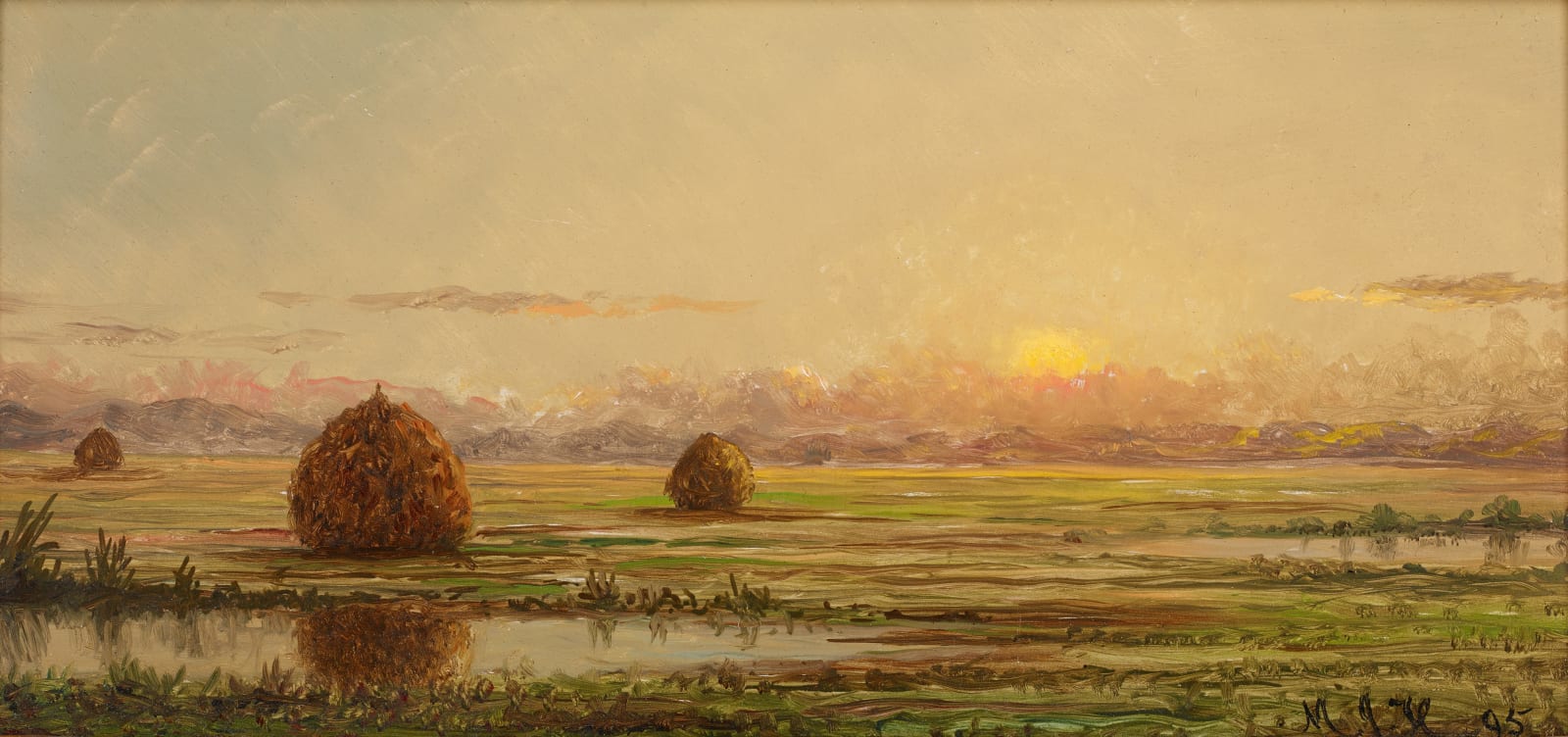Martin Johnson Heade 1819-1904
Sunset - A Sketch, 1895
Oil on board
6 x 12 inches (15.2 x 30.5 cm)
Framed dimensions: 13 1/8 x 19 3/8 inches
Framed dimensions: 13 1/8 x 19 3/8 inches
Signed and dated lower right: M.J.H. 95
Although he has sometimes been associated with the Hudson River School of painters, possibly due in part to his close friendship with famed artist Frederic Edwin Church (1826-1900), Martin Johnson...
Although he has sometimes been associated with the Hudson River School of painters, possibly due in part to his close friendship with famed artist Frederic Edwin Church (1826-1900), Martin Johnson Heade's oeuvre is composed not only of landscape paintings, but also still lifes, portraits, and paintings of birds and tropical flora. Heade's style concentrated more so on the effects of light and the mood created by luminosity, rather than the topographically accurate views of Hudson River painters. In contrast to the Hudson River School's grandiose depictions of waterfalls, mountains, and valleys, Heade's typical landscapes display horizontal expanses of quiet scenery, avoiding vast splendor and instead showing petite haystacks and sometimes figures. He is most renowned for his coastal salt marsh landscapes, mainly painted in New England. His affinity for seascapes and marshes resulted in many of his best works, praised for their adroit representation of atmospheric light and meteorological conditions.
Born in Lumberville in Bucks County, Pennsylvania, he exhibited his very first works at the Pennsylvania Academy of the Fine Arts, and traveled several times to and from Europe in the late 1840s. In the late 1850s his interest in landscape painting was piqued due in part to his acquaintance with artists John Frederick Kensett (1816-1872) and Benjamin Champney (1817-1907). He would later move into a New York City apartment building where some of the Hudson River School painters resided, including Church. Heade traveled widely, spending a fair amount of time in Brazil, where he studied and painted hummingbirds, orchids and tropical landscapes. He would eventually settle in Saint Augustine, Florida, where he would live and work until his death.
In Sunset, Heade subtlety captures the effects of the setting sun on this quiet landscape. He composes the scene in a horizontal format, a composition style that was popular with Luminist painters. Haystacks in marsh land were a favorite subject for the artist, one that he explored repeatedly throughout his career. Heade carefully observed the details of the natural world, but did not slavishly copy them. Instead he wanted to capture the unique characteristics of the landscape not the exact location. He believed the marsh held universal meaning as a place for introspection and contemplation – a place to commune with nature in quiet solitude.
Born in Lumberville in Bucks County, Pennsylvania, he exhibited his very first works at the Pennsylvania Academy of the Fine Arts, and traveled several times to and from Europe in the late 1840s. In the late 1850s his interest in landscape painting was piqued due in part to his acquaintance with artists John Frederick Kensett (1816-1872) and Benjamin Champney (1817-1907). He would later move into a New York City apartment building where some of the Hudson River School painters resided, including Church. Heade traveled widely, spending a fair amount of time in Brazil, where he studied and painted hummingbirds, orchids and tropical landscapes. He would eventually settle in Saint Augustine, Florida, where he would live and work until his death.
In Sunset, Heade subtlety captures the effects of the setting sun on this quiet landscape. He composes the scene in a horizontal format, a composition style that was popular with Luminist painters. Haystacks in marsh land were a favorite subject for the artist, one that he explored repeatedly throughout his career. Heade carefully observed the details of the natural world, but did not slavishly copy them. Instead he wanted to capture the unique characteristics of the landscape not the exact location. He believed the marsh held universal meaning as a place for introspection and contemplation – a place to commune with nature in quiet solitude.
Provenance
Frederick Mont and Victor Spark, New York, New York;Ernest Rosenfeled, New York, New York;
Parke-Bernet, New York, sale of November 18, 1965, lot 57;
Acquired directly from the above sale;
Collection of Edward E. White, New York;
By descent in the family;
Sotheby's, New York, sale of May 24, 2006, lot 1;
Acquired directly from the above sale;
Collection of Dorrance H. Hamilton;
Freeman's, Philadelphia, sale of April 29, 2018, lot 21;
Acquired directly from the above sale
Exhibitions
Butler Museum of American Art, Youngstown, Ohio, 1958-1965 (on loan).Literature
Theodore E. Stebbins, Jr., The Life and Work of Martin Johnson Heade: A Critical Analysis and Catalogue Raisonné,New Haven, Connecticut, 2000, p. 277, no. 303 (illustrated).Please join our mailing list
* denotes required fields
We will process the personal data you have supplied in accordance with our privacy policy (available on request). You can unsubscribe or change your preferences at any time by clicking the link in our emails.



